Analyzing Intel Core M Performance: How 5Y10 can beat 5Y71 & the OEMs' Dilemma
by Brett Howse & Ian Cutress on April 8, 2015 8:00 AM ESTTouchXPRT 2014 Results
TouchXPRT performs several tasks, and the workloads very much fall into the race to sleep category. There are several workloads, from adding filters to photos, to creating podcasts. The benchmark takes about ten minutes to complete, but each workload is slightly different.
Looking at the Core i5 graph makes it very obvious where the heaviest lifting is in this benchmark, but even that one is full of bursts of work. The Dell Venue tablet is able to hit a very high frequency for many of these tasks, since it has adequate time to cool off in between. The ASUS is as consistent as always, and the Yoga 3 Pro can really stretch its legs on this benchmark.
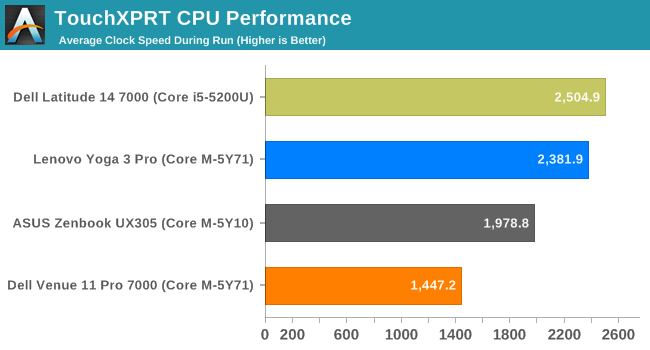
Looking at the average CPU frequency, the Yoga 3 Pro beats out the other Core M devices by a lot, and even turbo higher than the Core i5 on many occasions. If the work is short, the higher burst frequency of the 5Y71 can make a big difference. This would be very similar to web browsing, where short bursts of work get the job done. The Dell has the lowest average CPU frequency again, but as we have seen in previous results the fact that it can hit a much higher frequency than the ASUS can help it regain ground, especially on a short workload such as this one.
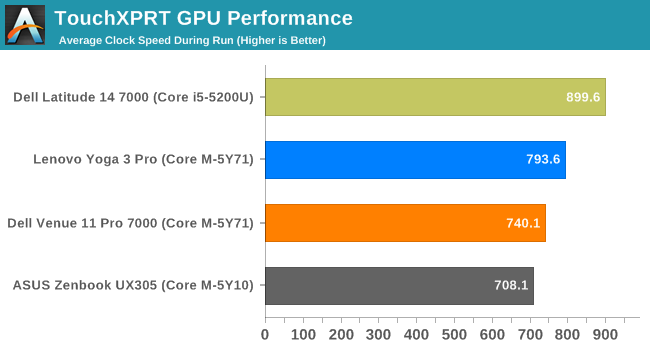
The GPU average frequencies show the disadvantage of the 5Y10. It is quite a bit under the 800 MHz turbo frequency of the chip, and it cannot turbo to the 900 MHz of the other two chips when it does have thermal headroom to make up the difference. The other two devices can be seen to jump all the way up to the 900 MHz maximum many times.

Temperatures are low, and the ASUS is the lowest again. The Yoga 3 Pro is sitting right at the 65°C target temperature, which means it was not always able to keep within that target during these quick bursts of energy needed.
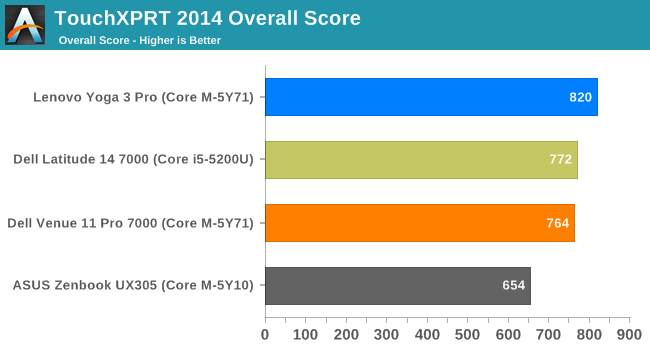
TouchXPRT is almost a perfect workload for 5Y71, and the Yoga 3 Pro outperforms even the Core i5-5200U in this test. The Venue 11 Pro also comes in right at the score of the Core i5. The ASUS UX305 is certainly hampered by its lack of turbo compared to the other devices in this test. It had the lowest average temperature, and it could not do anything with it.



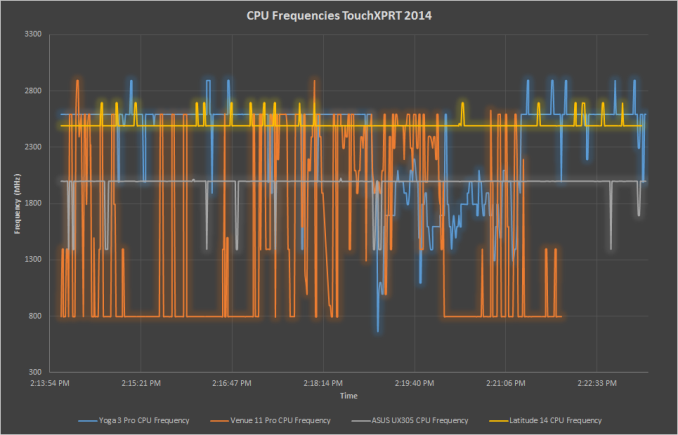
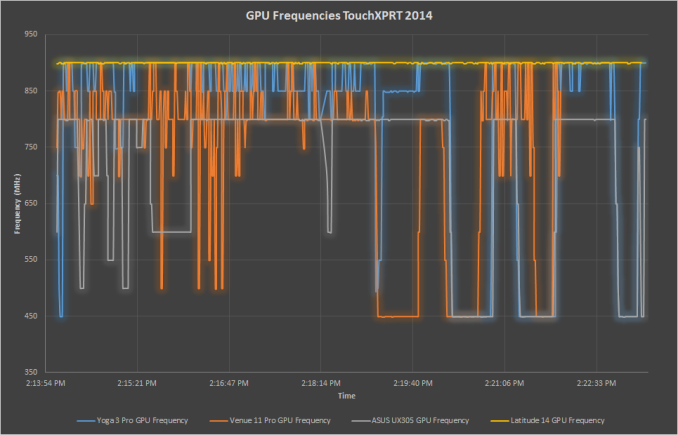
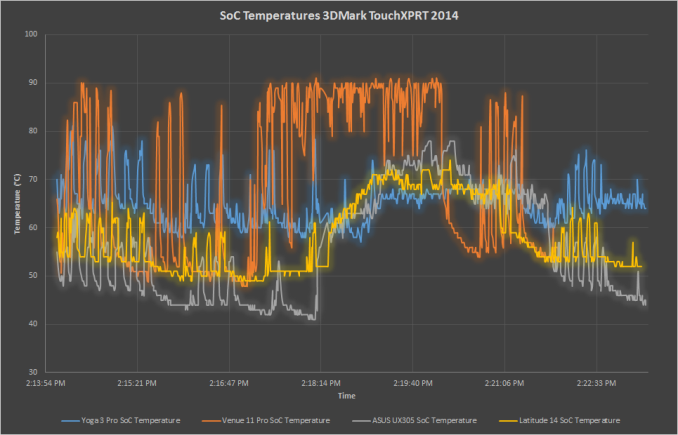








110 Comments
View All Comments
maxxbot - Wednesday, April 8, 2015 - link
If the device buyer's choice is between the Core M and an ARM or Atom they're going to go with the Core M because it's faster in every aspect, especially burst performance. If the Core M in unacceptable slow for you then there aren't any other options at the 4.5W TDP level to turn to, it's the best currently available.name99 - Wednesday, April 8, 2015 - link
That ("Maybe Intel made too many compromises") seems like the wrong lesson.I think a better lesson is that the Clayton Christensen wheel of reincarnation has turned yet again.
There was a time more than 40 years ago when creating a computer was a demanding enough exercise that the only companies that could do it well were integrated top to bottom, forced to do everything from designing the CPU to the OS to the languages that ran on it.
The PC exploded this model as standardized interfaces allowed different vendors to supply the BIOS, the OS, the CPU, the motherboard, the storage, etc.
BUT as we push harder and harder against fundamental physics and what we want the devices to do, the abstractions of these "interfaces" start to impose serious costs. It's no longer good enough to just slap parts together and assume that the whole will work acceptably. We have seen this in mobile, with a gradual thinning out of the field there; but we're poised to see the same thing in PCs (at least in very mobile PCs which, sadly for the OEMs, is the most dynamic part of the business).
This also suggests that Apple's advantage is just going to keep climbing. Even as they use Intel chips like everyone else, they have a lot more control over the whole package, from precisely tweaked OS dynamics to exquisitely machined bodies that are that much more effective in heat dissipation. (And it gets even worse if they decide to switch to their own CPU+GPU SoC for OSX.)
It's interesting, in this context, where the higher frequency 1.2GHz part is difficult for some vendors to handle, to realize that Apple is offering a (Apple-only?) 1.3/2.9GHz option which, presumably, they believe they have embodied in a case that can handle its peak thermals and get useful work out of the extra speed boost.
HakkaH - Friday, April 10, 2015 - link
Device buyers don't even see beyond the price tag, brand name and looks. 90% of the people who buy tech are pretty oblivious on what they are buying. So they wouldn't even know if a device would throttle the speed at all.Secondly I'd rather have a device that throttles good which processors are doing the last couple of years than have a steady pace at which it just crawls along and maybe after 5 minutes decides... hey maybe I can add 200 MHz and still be okay. If that is your case I bet you still have the first generation smartphone in your pocket instead of a more recent model because they all aggressively throttle the CPU and GPU in order to keep you from throwing your phone out of your hands ;)
HP - Saturday, August 8, 2015 - link
Your description doesn't follow the usage paradigm of most computing tasks. As the user is actively using their device what they do on the machine roughly tracks the user's thought patterns which largely takes place in series. He doesn't batch the tasks in his head first and then execute them. So race to sleep is where it's at.milkod2001 - Wednesday, April 8, 2015 - link
What about Intel's native 4 core mobile CPUs. Are any in the works?Core M,Y, U(2 core) etc might be OK for bloggers, content consumers etc but if one wants/needs real performance on the go, there's not that much new to offer, right?
nathanddrews - Wednesday, April 8, 2015 - link
I think we'll have to settle for the i7-4700 until Skylake. Not a bad place to settle.kpkp - Wednesday, April 8, 2015 - link
"Atom competed against high powered ARM SoCs and fit in that mini-PC/tablet to sub 10-inch 2-in-1 area either running Android, Windows RT or the full Windows 8.1 in many of the devices on the market."Atom in Windows RT? Wasn't RT ARM only?
Essence_of_War - Wednesday, April 8, 2015 - link
Very impressed by the Zenbook, especially at its price point.boblozano - Wednesday, April 8, 2015 - link
Thanks for the detailed article.In this space it's clear that the top design consideration is cooling - do that well, and everything else follows. Performance will be delivered by the SoC's ability to turbo as needed, power consumption by the SoC and the rest of the design.
Of course materials, size, the question of passive vs. active cooling ... all that also factors decisively into the success of a design, whether the target market actually buys the devices.
But the effectiveness of the cooling will largely determine performance.
Refuge - Wednesday, April 8, 2015 - link
The efficiency of the cooling too. Can't have it take up too much space or too much power (If active and not passive)otherwise you leave either no room for your battery, or you drain it too fast keeping the thing cool (In the case of active)